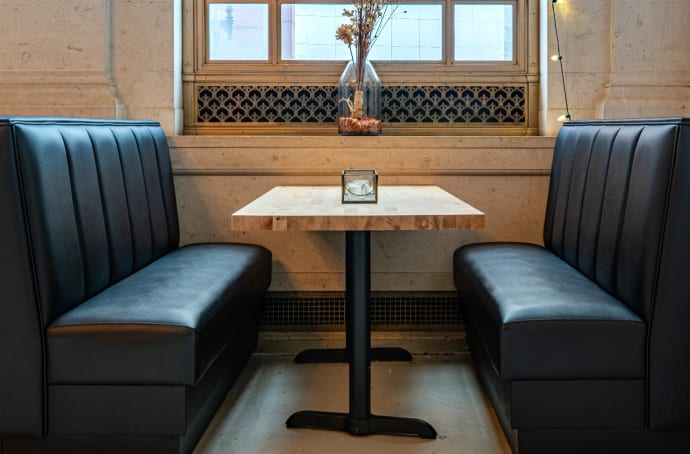In the bustling world of the culinary industry, every restaurant strives to set itself apart, not just through its delectable cuisine but also through its ambiance. Among the myriad of design elements that contribute to the overall atmosphere of a restaurant, booth seating stands out as a timeless favorite. Restaurant booths offer a unique blend of comfort, privacy, and aesthetic appeal, making them an indispensable asset for any dining establishment.

The Importance of Restaurant Booths
Restaurant booths are more than just seats; they are integral components of the dining experience. Unlike conventional chairs, booths provide a sense of intimacy and seclusion, allowing diners to enjoy their meals in a cocoon of comfort. This sense of privacy makes booths particularly appealing for couples on romantic dates, families seeking quality time together, or business professionals engaging in discreet discussions.
Furthermore, booth seating optimizes space utilization, especially in establishments with limited square footage. By hugging the walls, booths create pathways for easy navigation while maximizing the seating capacity of the restaurant. This strategic arrangement not only enhances the flow of foot traffic but also contributes to a cozy, inviting ambiance.
Design Considerations for Restaurant Booths
When integrating booths into your restaurant's layout, it's crucial to consider various design elements to ensure optimal functionality and aesthetics. From materials and dimensions to upholstery and lighting, every aspect plays a pivotal role in crafting an immersive dining experience.
Materials and Construction
Selecting the right materials for your restaurant booths is paramount to their longevity and visual appeal. Whether opting for classic wooden booths, sleek metal frames, or plush upholstered seating, ensure that the materials align with your restaurant's theme and brand identity. Additionally, prioritize durability to withstand the rigors of daily use and maintenance.
Dimensions and Layout
The dimensions of booths should strike a balance between comfort and space efficiency. Consider factors such as seat depth, backrest height, and table placement to accommodate diners of all shapes and sizes while optimizing seating capacity. Additionally, explore different booth layouts, such as L-shaped, U-shaped, or circular configurations, to maximize space utilization and create visually engaging dining areas.
Upholstery and Finishes
The upholstery of your restaurant booths serves as a canvas for expressing your establishment's personality and style. Whether opting for luxurious leather, vibrant fabrics, or easy-to-clean materials, choose finishes that complement your overall decor scheme and evoke the desired ambiance. Pay attention to details such as stitching, piping, and button tufting to add a touch of sophistication to your booth seating.
Lighting and Ambiance
Lighting plays a crucial role in accentuating the allure of your restaurant booths and setting the mood for an unforgettable dining experience. Incorporate ambient lighting fixtures, such as pendant lights, wall sconces, or recessed LEDs, to create a warm, inviting atmosphere. Experiment with dimmers and color temperatures to customize the lighting intensity and ambiance according to the time of day and dining occasion.
Customizing Your Restaurant Booths
One of the greatest advantages of restaurant booths is their versatility and customization options. Whether refurbishing existing booths or designing new ones from scratch, leverage the expertise of interior designers and furniture manufacturers to bring your vision to life. From fabric swatches and sample finishes to CAD drawings and 3D renderings, explore a myriad of customization possibilities to tailor your booth seating to the unique identity of your restaurant.
Branding and Identity
Restaurant booths offer an excellent opportunity to reinforce your brand identity and leave a lasting impression on diners. Incorporate branded elements such as logo embroidery, custom patterns, or signature colors into the upholstery and finishes to create a cohesive look that reflects your restaurant's ethos. Additionally, consider integrating multimedia features such as built-in screens or sound systems to enhance the dining experience further.
Ergonomics and Comfort
Prioritize ergonomics and comfort when designing your restaurant booths to ensure a pleasurable dining experience for your guests. Pay attention to factors such as lumbar support, seat cushioning, and armrest height to promote proper posture and alleviate discomfort. Consider incorporating adjustable features such as reclining mechanisms or swivel seats to accommodate individual preferences and enhance overall comfort levels.
Accessibility and Inclusivity
Incorporate ADA-compliant features into your restaurant booths to ensure accessibility for guests with disabilities. Consider factors such as aisle width, seat height, and grab bar placement to facilitate seamless navigation and comfortable seating for all patrons. Additionally, train your staff to provide assistance and accommodation to guests with special needs, ensuring that every diner feels welcome and valued.
Conclusion
In conclusion, restaurant booths are invaluable assets that can elevate the dining experience and set your establishment apart in a competitive market. By carefully considering design elements such as materials, dimensions, upholstery, and lighting, you can create booth seating that not only maximizes comfort and functionality but also reinforces your brand identity and enhances the overall ambiance of your restaurant. Embrace customization options to tailor restaurant booths to the unique character of your establishment, ensuring a memorable dining experience for every guest.